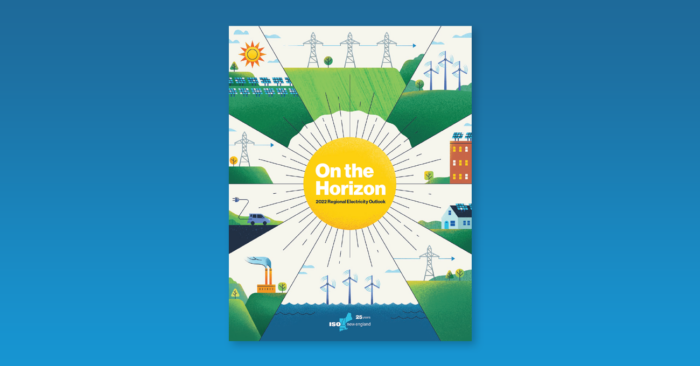On the Horizon: New England’s 2022 Regional Electricity Outlook examines four pillars needed to support tomorrow’s greener grid

ISO New England has published its 2022 Regional Electricity Outlook (REO), an annual report looking at the trends affecting New England’s power system and the solutions the ISO is pursuing to ensure reliable electricity for the region’s homes and businesses—today and into the future.
Published this year on the 25th anniversary of the ISO’s inception, the 2022 REO examines the four pillars that will support tomorrow’s greener grid.
Included in the REO is a letter from Gordon van Welie, president and CEO of ISO England, and Cheryl LaFleur, chair of ISO New England’s Board of Directors, that reflects on the progress already made toward achieving the region’s clean energy future and the challenges that remain ahead. It is shared in full below.
This year’s Regional Electricity Outlook finds us at a pivotal point in the ISO’s and the region’s energy history: nearly equidistant from the formation of ISO New England in 1997, and the mid-century realization of regional climate goals aimed at drastically reducing carbon emissions. Over the course of the next two decades, our region’s electric grid will likely more than double in size, expanding to incorporate vast amounts of renewable resources and serve increasing demand for electricity as more sectors decarbonize.

This transformation is already well underway in the region’s power system, and the impact it will have on New England for generations to come cannot be overstated. The four key pillars required to support this future grid—significant amounts of clean energy resources, sufficient balancing resources to ensure reliability, a reliable fuel supply or energy storage reserve, and a robust transmission system—are explored in these pages, along with the ways in which the ISO is supporting each one through the execution of our responsibilities to operate the region’s electricity grid, administer the wholesale electricity markets, and plan for a reliable power system.
At the ISO, our talented workforce is striving to ensure New England’s grid is prepared to provide the region with clean, reliable, cost-effective electricity today—and throughout our journey to the clean energy future. We are proud of the work we’ve done since our inception to be good stewards of the region’s electricity system, including responding to states’ objectives in planning and operating our grid. We take our responsibility to fulfill our vision—to harness the power of competition and advanced technologies to reliably plan and operate the grid as the region transitions to clean energy—very seriously.

We are studying every aspect of today’s evolving electric system so the region is ready for the substantially changed one coming tomorrow. Achieving and maintaining a greener grid requires us to leverage all clean energy resources and technologies—from existing nuclear, hydro, wind, and solar generation, to all the new renewable resources under development or being proposed—including new wind, solar, and grid-scale battery storage. We also stand ready to support the development of other emerging clean technologies for the future. We believe competitive markets provide the best opportunity to cost-effectively meet states’ environmental goals, while also maintaining balancing resources to meet system reliability needs. In the short term, a key focus will be ensuring New England’s energy markets appropriately compensate balancing resources for the reliability services they provide. At the same time, we are exploring the impact climate-driven extreme weather and increasing electrification of other business sectors will have on power system operations and the need for additional transmission to transmit clean energy to New England’s homes and businesses.
We are eager to continue working through these complex challenges with all stakeholders to secure New England’s clean energy future. Consequently, we must acknowledge that some of the pillars discussed in these pages present issues that competitive markets alone can’t solve, and others that are beyond the ISO’s scope of responsibility. Decisions on siting and permitting, for example, can be delayed for years and neither the ISO nor wholesale markets can override these decisions. An agreed-upon mechanism for funding transmission development in support of decarbonization goals is also needed.
One of the most pressing challenges the region must address is energy adequacy, which the ISO has been concerned about for nearly two decades. Recently, events in the U.S. and around the globe continue to demonstrate that low probability, high impact risks cannot be ignored. While the wholesale electricity markets drive resource development to meet the needs of the system, it is unlikely these markets will sufficiently incent investments to cover more extreme and uncertain scenarios, even though these scenarios are happening with more and more frequency. Finding a solution to this problem is critical for New England—not only for today, but for tomorrow. Reliability must be sustained throughout our journey, assuring stakeholders that our future electric power grid will be as reliable as it is clean.
Over the years, the region has become more reliant on imported fuels and the need for a robust and sustainable solution has grown more urgent. Increasingly, we are reminded—as we were during the pandemic, and more recently with the Russian incursion into Ukraine—that geopolitical events are quickly felt locally, exacerbating supply issues and increasing both supply risk and pricing uncertainty. Urgency is warranted—in the past two years, four out of seven independent service operators and regional transmission organizations in the U.S. have resorted to controlled outages because extreme weather limited energy supplies. Although that hasn’t happened here, the fact is New England’s grid is susceptible to risk from multiple factors throughout the coldest months of the year.
As ISO New England prepares for the upcoming winter and future winters, we are cognizant of these system vulnerabilities and will continue working with the states and regional stakeholders to solve the region’s energy adequacy needs while also doing our part to bring about a clean and reliable energy future.
Over the last 25 years, ISO New England has laid the foundation to support the four pillars discussed in this report and the region is already well along the path to a clean energy future. As we keep our eyes on the horizon, New England has an opportunity to serve as a model for what a sustainable, reliable, and efficient transition can look like.
- Categories
- Publications
- Tags
- clean energy, energy adequacy
